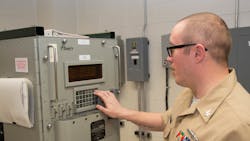Sperry Marine continues to build AN/WSN-7 shipboard navigation systems as Navy waits for new replacement
WASHINGTON –WASHINGTON – U.S. Navy shipboard navigation and guidance specialists are continuing their efforts to squeeze all the life they can out of the AN/WSN-7 ring laser gyro navigation system for Navy surface vessels and submarines.
Officials of the Naval Sea Systems Command in Washington announced an $15.8 million order Wednesday to the Northrop Grumman Corp. Sperry Marine segment in Charlottesville, Va., to support the company's AN/WSN-7 navigation system.
The order is a one-year option to produce ring laser gyro navigation (RLGN) systems, provisioned items, and technical program support of the Navy's WSN-7 navigation system.
The AN/WSN-7 is a self-contained, ring laser gyro inertial navigation system that senses ship motions, computes the ship's precise position, velocity, attitude, heading, and rates in digital and analog formats, and forwards the data to other vital ship systems.
Related: Northrop Grumman to develop new Navy shipboard navigation system to replace ageing AN/WSN-7
The WSN-7 has been in service with the Navy for decades, and was designed as a replacement for spinning-mass gyro navigation equipment aboard Navy warships. The system is as a more reliable strapdown ring laser gyro-based replacement for the old WSN-2 navigation system.
The AN/WSN-7 offers accuracy of one nautical mile deviation over 24 hours. Navy officials are extending the life of the WSN-7 shipboard navigation system as long as possible as they develop a WSN-7 replacement.
Sperry Marine is developing the Inertial Navigation Systems Replacement (INS-R) Inertial Sensor Module (ISM) as a replacement for the WSN-7, to enable surface vessels to navigate accurately without GPS satellite navigation. This new system will be called the AN/WSN-12.
Sperry Marine reported completion of the ISM's preliminary design review in May 2016. The ISM will be a critical component on the INS-R WSN-12 replacement for the WSN-7. Preliminary design review means a system is operationally effective, and clears the way for detail design. First deliveries of WSN-12 engineering development models are schedule for later this year.
Related: Northrop Grumman keeps Navy shipboard navigation running while looking for new technologies
The INS-R will provide mission critical ship positioning, velocity, and altitude data to shipboard sensors, combat systems, guns, and missile systems. It will use an open-systems architecture using a modular design, standards-based interfaces, and widely supported consensus-based standards.
The AN/WSN-7, meanwhile, uses 25-year-old technology based on the NATO MK 49 inertial navigation system deployed in the late 1980s. The INS-R will provide improved real-time navigation for Navy surface warships, and enable future technology growth.
The standard WSN-7 shipboard configuration consists of two independent cabinets for redundancy and survivability. It is not be susceptible to jamming or detection by enemy forces.
The ring laser gyro uses two counter-propagating laser beams operating on different frequencies with the difference dependent on rotation rate. Measurement of this difference provides the rotation angle or rotation rate about the device's sensitive axis.
Compared with older spinning-mass gyro navigation systems, ring laser gyros are much smaller, do not resist changes in direction, are frictionless, have low power consumption, and feature almost no moving parts to enhance reliability while still providing adequate accuracy.
On this order Sperry Marine will do the work in Charlottesville, Va., and should be finished by July 2021. For more information contact Northrop Grumman Sperry Marine online at www.northropgrumman.com, or Naval Sea Systems Command at www.navsea.navy.mil.

John Keller | Editor-in-Chief
John Keller is the Editor-in-Chief, Military & Aerospace Electronics Magazine--provides extensive coverage and analysis of enabling electronics and optoelectronic technologies in military, space and commercial aviation applications. John has been a member of the Military & Aerospace Electronics staff since 1989 and chief editor since 1995.

